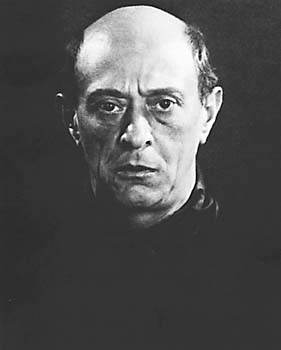Reflections series offers strong Shostakovich and a Schoenberg rarity

Arnold Schoenberg
Violinist Gil Morgenstern is the artistic director and curator of the Reflections series at the Bass Museum of Art in Miami Beach. On Sunday afternoon Morgenstern offered an unusual trio version of Schoenberg’s Verklarte Nacht (Transfigured Night) and Shostakovich’s Piano Trio in E minor, a 20th-century classic.
Morgenstern’s urbane commentary is an important component of his audience-friendly chamber series. With offbeat programming and an interesting rotating roster of musicians, Reflections is a welcome addition to South Florida’s small scale, alternative performance series.
Schoenberg’s Verklarte Nacht is a landmark score. Originally conceived as a string sextet and later expanded for string orchestra by the composer, Verklarte Nacht represents the twilight of musical romanticism. Schoenberg stretched expressive passion to the breaking point, even outdistancing Wagner in Tristan and Isolde. Edward Steuermann, a Schoenberg pupil, made a transcription of the work for piano, violin and cello in 1932.
Morgenstern deserves kudos for offering an opportunity to hear an unusual arrangement by a member of Schoenberg’s Viennese circle. In his introductory remarks, the violinist admitted honestly that there are inherent problems with this version. Introducing a keyboard line, often playing multiple violin figurations, changes the texture of the score and reduces the emotional intensity level considerably. While skillfully conceived, this version fails to effectively channel Schoenberg’s farewell to tonality.
Morgenstern remains an adept and nimble player. He certainly gave Steuermann’s realization a strongly projected performance, seconded by cellist Ole Akahoshi. Donald Berman, a contemporary music specialist, did his best to balance the piano line against the strings and bring clarity to the instrumental texture. While that proved a thankless task, his dedication and artistry remained impressive.
While the performance of Shostakovich’s wartime trio was not terribly subtle, this music thrives on power and unhinged intensity and the players offered that level of combustion. In the resonant gallery space, the eerie high harmonics of the opening presaged the musicians’ vigorous attack, magnifying the music’s disturbing impact. The players’ rhythmic drive in the second movement conveyed the music’s wild, fury.
In the Largo, Shostakovich bears the agony of his soul, as so often in his chamber scores. Here Akahoshi’s dark, voluminous tone cut deep but string intonation went awry near the movement’s conclusion. Berman’s powerful articulation of the finale’s dance of death set the hard driving tone, making the cataclysmic coda all the more heart rending for its tragic simplicity. For its flaws and fitful lack of polish, this was a performance that still cut to the quick of Shostakovich’s searing music.
Posted in Performances
Leave a Comment
Tue Apr 12, 2011
at 12:53 am
No Comments






